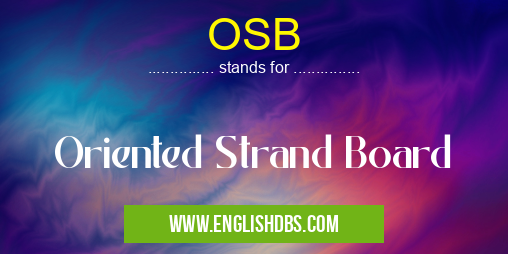What does OSB mean in ARCHITECTURE
Oriented Strand Board, commonly referred to as OSB, is a type of engineered wood product composed of strands of wood that are bound together with waterproof adhesive resin and then compressed into large boards. A sheet of OSB typically has a higher density and strength than plywood, making it an ideal material for construction projects such as roof sheathing, wall plybase sheathing and flooring. The unique manufacturing process of OSB also allows it to be used in a variety of other applications such as furniture components, doors and paneling.

OSB meaning in Architecture in Academic & Science
OSB mostly used in an acronym Architecture in Category Academic & Science that means Oriented Strand Board
Shorthand: OSB,
Full Form: Oriented Strand Board
For more information of "Oriented Strand Board", see the section below.
What is OSB?
OSB is formed when thin veneer-like layers or "strands" of wood are heated and bonded together with waterproof adhesives under intense pressure. The strands used to make OSB can be sourced from a number of different trees species, including yellow poplar, white pine, spruce and fir. Once the strands have been arranged in the desired pattern they are compressed between two steel plates until they form a solid board. This method of manufacture results in an extremely strong product that can resist warping and twisting much better than standard plywood. OSB panels come in a variety of thicknesses ranging from 1/8" to 1-1/8" thick and have superior nail holding capacity making them suitable for use in many different types of construction projects.
Benefits
The primary benefit that comes with using OSB instead of plywood is its strength compared to weight ratio. As mentioned above, OSB panels have a higher density and strength than standard plywood which makes them well suited for applications where the load bearing needs are high but the weight needs to remain low. This makes them particularly well suited for use on roofs where heavy snowfall could cause traditional plywood boards to sag over time or even collapse under excessive weight. Additionally, because the resins used in their manufacturing process provide the panel with waterproof properties they are also often preferred over plywood when using outdoors or when exposed to moisture laden environments such as bathrooms or kitchens.
Essential Questions and Answers on Oriented Strand Board in "SCIENCE»ARCHITECTURE"
What is Oriented Strand Board (OSB)?
OSB is an engineered wood-based panel product consisting of strands or flakes of wood that are oriented and layered, with a bonding resin that holds them together. It is mostly used in construction for flooring, walls, and roof decking.
Is OSB waterproof?
Yes, OSB is water-resistant as it has a very high degree of water resistance. However, prolonged exposure to water exposure can cause damage over time.
Is OSB stronger than plywood?
In general terms, OSB has greater shear strength when compared to the same thickness of plywood. OSB panels also tend to be more uniform and consistent in quality than plywood panels due to their manufacturing process.
What type of adhesive is used for OSB?
The most commonly used adhesive for manufacturing edged panels of oriented strand board (OSB) is phenol-formaldehyde resins. Phenol-formaldehyde resins are known for providing superior adhesion and improved durability in environments exposed to moisture or wetness conditions such as those found outdoors or in kitchens and bathrooms indoors.
Does OSB contain formaldehyde?
Yes, the resins used to bind the wood strands together often contain trace amounts of formaldehyde which may potentially emit from the OSB product over time.
How do I seal my OSB board to minimize off-gassing potential?
You can use sealants such as polyurethane-based products or paint on your sealed board surface. This will help minimize any chance for emission of formaldehyde or other volatile compounds from off-gassing.
How durable is Oriented Strand Board (OSB)?
When properly sealed and maintained, Oriented Strand Board should last multiple years without any major problems. While not necessarily as durable as plywood under certain conditions (e.g. outdoor use), you can expect good performance when using indoors.
What climate zone does OBS perform best in?
Generally speaking, Oriented Strand Board performs best in climates classified as moderate humidity level/temperature zones since this minimizes swelling/shrinking due to changes in temperature/humidity levels which could lead to delamination over time.
Are there health issues associated with installing OSB?
As noted previously, some binding agents have the potential to emit formaldehyde over time which could create health concerns if aerial concentrations become too high within an enclosed environment where frequent occupancy takes place. Proper sealing techniques should alleviate any risks associated with airborne concentrations of hazardous chemicals.
Final Words:
In conclusion Oriented Strand Board (OSB) is an excellent building material choice when strength-to-weight performance matters most. It is easy to work with allowing it to be easily cut shaped or drilled into any sort of configuration desired while still providing stability thanks to its dense bonding structure and waterproofing capabilities. It may cost more up front than other building materials but due to its durability it will save you money over time by not having require replacing every few years like some materials may need.
OSB also stands for: |
|
| All stands for OSB |
